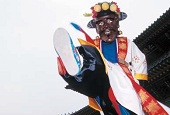-
 Korea.net's 24-hour YouTube channel
Korea.net's 24-hour YouTube channel- NEWS FOCUS
- ABOUT KOREA
- EVENTS
- RESOURCES
- GOVERNMENT
- ABOUT US
View this article in another language
- 한국어
- English
- 日本語
- 中文
- العربية
- Español
- Français
- Deutsch
- Pусский
- Tiếng Việt
- Indonesian
*This is the second part in our series, “Masks & the Mask Dance” published in partnership with the National Research Institute of Cultural Heritage
Different kinds of masks and their characteristics
Masks of all kinds can be found in every part of the world, but Korean masks contain their own unique shapes and functions. Korean masks are generally divided into ritual and theatrical masks; ritual masks are used for exorcisms or religious ceremonies, while theatrical masks are important in dance and dramatic performances. We will start by examining different ritual masks to define some of the main characteristics of Korean masks.
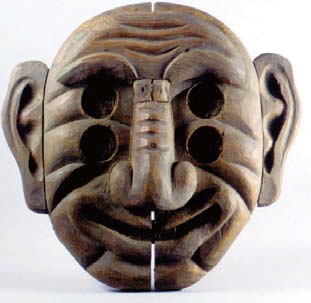
Bangsangssi mask
The Bangsangssi mask is considered the oldest traditional mask in Korea, passed down from the Silla Dynasty, around the 6th century. Having four eyes, it was designed to protect the dead from evil spirits.
Designated as Important Folklore Material No. 16, the mask pictured here is the only such Joseon-era mask remaining today. It was constructed from pine, is 72 centimeters long and 74 centimeters wide, and was mainly used for court functions. These masks were generally placed in front of funeral biers to banish evil spirits during funeral services or used in royal exorcism ceremonies.
The Bangsangssi mask was used to banish evil spirits during funeral services. It was commonly made of paper, rice straw or wood and buried near the grave or burnt after use, out of the belief that masks were prone to attract misfortune, illness or mishap.
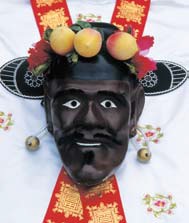 Cheoyong mask
Cheoyong mask
The Cheoyong mask was derived from the legend of Cheoyong. It was made by using carved lime wood or lacquered hemp cloth. The branch of a peach tree hanging at the head of the mask and the dark red color of the face serve to drive away malignant spirits.
The Dance of Cheoyong has been passed down from the Goryeo Dynasty as a part of exorcism ceremonies. Dancers wear Choeyong masks during performances.
While no longer performed as an exorcism, the Dance of Cheoyong still occurs as part of traditional dance performances. As a result, the Cheoyong masks are now classified as theatrical masks.
Unique functions of masks used for mask dance performances
Korean masks were intended primarily for use in religious activities, but that has changed over time. They originally served as tools for exorcism, but as the culture evolved, they became a central feature of artistic activities such as dance and drama performances.
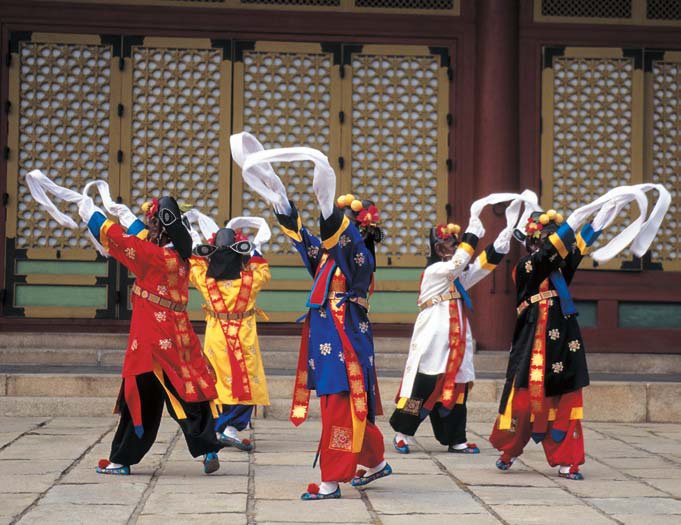
Since many different regions in Korea have unique forms of mask-dance dramas, there are a variety of regional versions of theatrical masks. Most of these theatrical masks depict the face of a human, but there are also masks portraying existing animals such as the lion or imaginary animals like Yeongno, a legendary monster. Some masks represent divine figures such as Obangsinjang (the gods of five directions) or Gaksi (the bride).
The lion, gods of five directions and bride masks serve not only as theatrical masks for mask performances but also as sacred masks in exorcisms.
Next, we will look at theatrical masks serving religious purposes in order to better identify the unique functions and characteristics of traditional Korean masks.
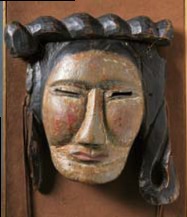 Gaksi (bride) mask
Gaksi (bride) mask
In the mask dance drama of the Hahoe village, the 'Hahoe drama to the gods,' the Gaksi, or Bride, represents a local guardian deity known as Seonangsin. Legend has it that a young woman died of a broken heart and was then transformed into a local goddess residing in the village.
One eye on the mask looks down while the other gazes straight ahead, suggesting the mask represents both the social restraints placed upon the bride and her determination to overcome them. The distinctively wide cheekbones portray one of the most common facial features found in many Koreans.
Sacred Hahoe masks
The residents of Hahoe village held all types of masks to be sacred, including the bride mask. They stored the masks separately in the village shrine and would not even approach the masks because misfortune would befall them if they touched them. In particular, the bride mask, as a local guardian deity, was considered so sacred that the villagers could safely look at it only after a shaman had offered it a sacrifice.
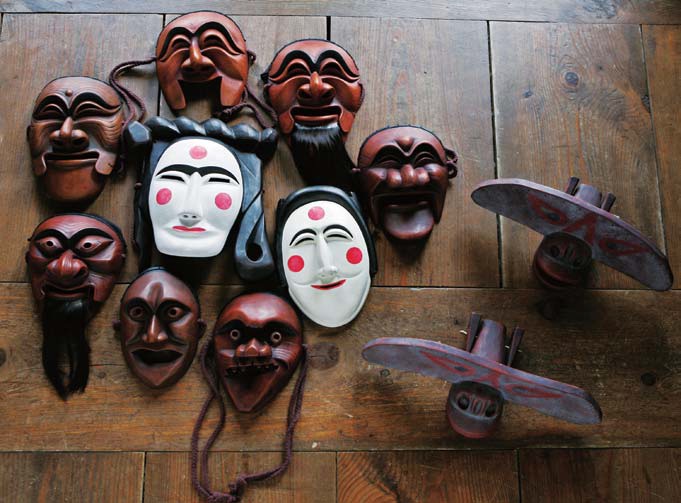
The Hahoe masks are said to have been made in the middle of the Goryeo Dynasty (918-1392). Currently there are a total of eleven Hahoe masks handed down from old times (maker and period unknown). They were designated as National Treasure No.121 in 1964 and are housed in the National Museum of Korea.
Lion mask
In ancient times, Koreans considered that lions contained the power to expel evil spirits and bring good luck. In the Goryeo period, they began to perform lion dances as part of exorcism rites at the beginning of a year. For the rites, people put on a frightful, oversized lion mask impressive enough to drive off evil spirits. The most important aspect of the lion mask is the golden eyes, which take after the gold-colored eyes of the four-eyed mask used in funeral services to expel negative spirits. Two types of mask dances, the Bongsan and Gangnyeong, make use of lion masks with rolling eyes and a large bell on its head. It is said that the bell rings whenever the lion moves in order to scare off demons.
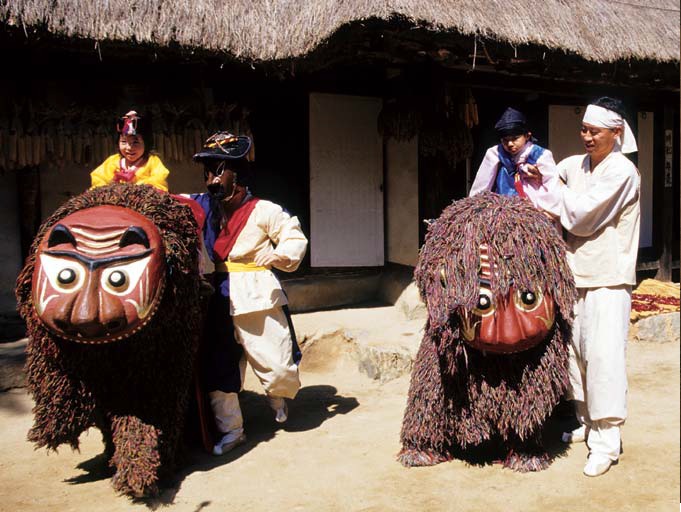
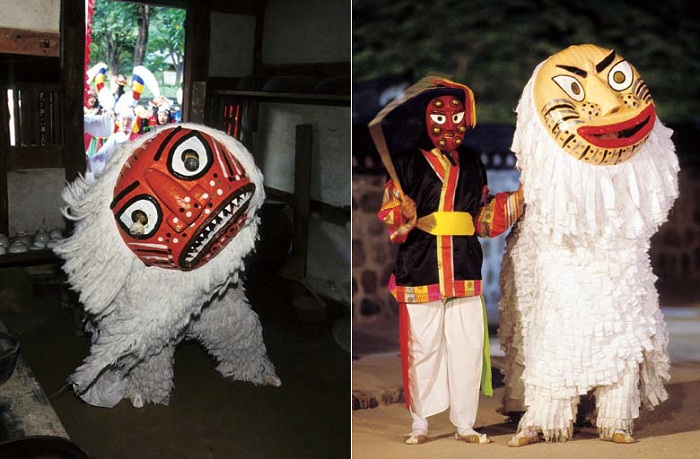
The traditional lion dance of the Bukcheong region is a classic example of Korean lion dance performances conducted as part of exorcism ceremonies. One folk belief is that children will enjoy good health and a long life if they are set on the lion’s back during the lion dance performance.
The gods of five directions masks
Obangsinjang refers to the gods of five directions (East, West, South, North and Center). These masks were believed to have exorcising powers as well. They were used for the Dance of the Gods of Five Directions, which was performed to expel demons from all directions of the area the mask dance was performed.
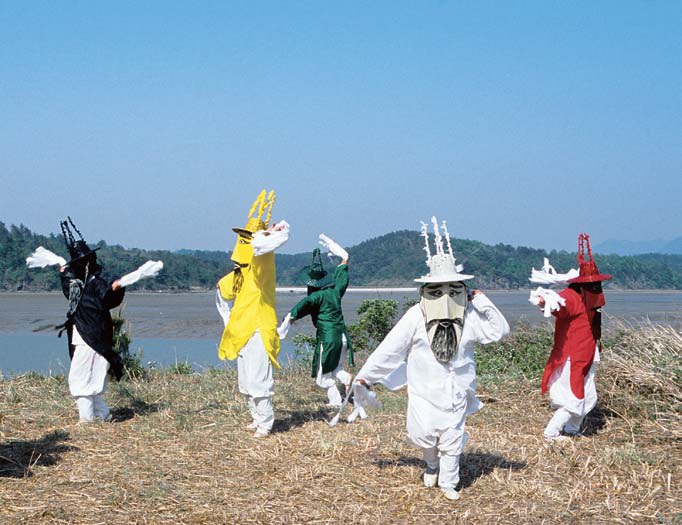
Among the mask dance performances still occurring, the traditional mask dance of the region of Gasan features this dance. Five actors wearing the masks and costumes of the five colors (blue for east, white for west, red for south, black for north and yellow for center) dance to expel evil spirits from the playground.
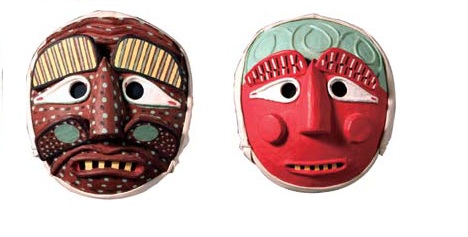
Nunggeumjeogi and Yeonnip masks
The Nunggeumjeogi and Yeonnip masks appear in the traditional mask dance of the Yangju region of Gyeonggi Province. These two masks represent symbolic religious characters that punish corrupt monks; the former scares away Omjung, a depraved monk with an itch, by personifying an evil spirit, while the latter scolds Sangjwa, a dishonest and youthful monk. This calls to mind the Bansangssi mask expelling bad spirits from funeral services. The mask dance of Yangju began with a sacrificial rite. The twin masks were placed on the ceremonial table and honored because they were believed to drive off bad spirits. In addition, the masks of Sangjwa and the eight corrupt monks are also considered theatrical masks with an exorcism function. Korean mask dance performances were strongly influenced by exorcism ceremonies. Nearly every masked performance features one or more exorcising mask and ritual dance.
*This series of article has been made possible through the cooperation of the National Research Institute of Cultural Heritage. (Source: Intangible Cultural Heritage of Korea)
Different kinds of masks and their characteristics
Masks of all kinds can be found in every part of the world, but Korean masks contain their own unique shapes and functions. Korean masks are generally divided into ritual and theatrical masks; ritual masks are used for exorcisms or religious ceremonies, while theatrical masks are important in dance and dramatic performances. We will start by examining different ritual masks to define some of the main characteristics of Korean masks.

Bangsangssi mask
The Bangsangssi mask is considered the oldest traditional mask in Korea, passed down from the Silla Dynasty, around the 6th century. Having four eyes, it was designed to protect the dead from evil spirits.
Designated as Important Folklore Material No. 16, the mask pictured here is the only such Joseon-era mask remaining today. It was constructed from pine, is 72 centimeters long and 74 centimeters wide, and was mainly used for court functions. These masks were generally placed in front of funeral biers to banish evil spirits during funeral services or used in royal exorcism ceremonies.
The Bangsangssi mask was used to banish evil spirits during funeral services. It was commonly made of paper, rice straw or wood and buried near the grave or burnt after use, out of the belief that masks were prone to attract misfortune, illness or mishap.

The Cheoyong mask was derived from the legend of Cheoyong. It was made by using carved lime wood or lacquered hemp cloth. The branch of a peach tree hanging at the head of the mask and the dark red color of the face serve to drive away malignant spirits.
The Dance of Cheoyong has been passed down from the Goryeo Dynasty as a part of exorcism ceremonies. Dancers wear Choeyong masks during performances.
While no longer performed as an exorcism, the Dance of Cheoyong still occurs as part of traditional dance performances. As a result, the Cheoyong masks are now classified as theatrical masks.
Unique functions of masks used for mask dance performances
Korean masks were intended primarily for use in religious activities, but that has changed over time. They originally served as tools for exorcism, but as the culture evolved, they became a central feature of artistic activities such as dance and drama performances.

Since many different regions in Korea have unique forms of mask-dance dramas, there are a variety of regional versions of theatrical masks. Most of these theatrical masks depict the face of a human, but there are also masks portraying existing animals such as the lion or imaginary animals like Yeongno, a legendary monster. Some masks represent divine figures such as Obangsinjang (the gods of five directions) or Gaksi (the bride).
The lion, gods of five directions and bride masks serve not only as theatrical masks for mask performances but also as sacred masks in exorcisms.
Next, we will look at theatrical masks serving religious purposes in order to better identify the unique functions and characteristics of traditional Korean masks.

In the mask dance drama of the Hahoe village, the 'Hahoe drama to the gods,' the Gaksi, or Bride, represents a local guardian deity known as Seonangsin. Legend has it that a young woman died of a broken heart and was then transformed into a local goddess residing in the village.
One eye on the mask looks down while the other gazes straight ahead, suggesting the mask represents both the social restraints placed upon the bride and her determination to overcome them. The distinctively wide cheekbones portray one of the most common facial features found in many Koreans.
Sacred Hahoe masks
The residents of Hahoe village held all types of masks to be sacred, including the bride mask. They stored the masks separately in the village shrine and would not even approach the masks because misfortune would befall them if they touched them. In particular, the bride mask, as a local guardian deity, was considered so sacred that the villagers could safely look at it only after a shaman had offered it a sacrifice.

The Hahoe masks are said to have been made in the middle of the Goryeo Dynasty (918-1392). Currently there are a total of eleven Hahoe masks handed down from old times (maker and period unknown). They were designated as National Treasure No.121 in 1964 and are housed in the National Museum of Korea.
Lion mask
In ancient times, Koreans considered that lions contained the power to expel evil spirits and bring good luck. In the Goryeo period, they began to perform lion dances as part of exorcism rites at the beginning of a year. For the rites, people put on a frightful, oversized lion mask impressive enough to drive off evil spirits. The most important aspect of the lion mask is the golden eyes, which take after the gold-colored eyes of the four-eyed mask used in funeral services to expel negative spirits. Two types of mask dances, the Bongsan and Gangnyeong, make use of lion masks with rolling eyes and a large bell on its head. It is said that the bell rings whenever the lion moves in order to scare off demons.


The traditional lion dance of the Bukcheong region is a classic example of Korean lion dance performances conducted as part of exorcism ceremonies. One folk belief is that children will enjoy good health and a long life if they are set on the lion’s back during the lion dance performance.
The gods of five directions masks
Obangsinjang refers to the gods of five directions (East, West, South, North and Center). These masks were believed to have exorcising powers as well. They were used for the Dance of the Gods of Five Directions, which was performed to expel demons from all directions of the area the mask dance was performed.

Among the mask dance performances still occurring, the traditional mask dance of the region of Gasan features this dance. Five actors wearing the masks and costumes of the five colors (blue for east, white for west, red for south, black for north and yellow for center) dance to expel evil spirits from the playground.

Nunggeumjeogi and Yeonnip masks
The Nunggeumjeogi and Yeonnip masks appear in the traditional mask dance of the Yangju region of Gyeonggi Province. These two masks represent symbolic religious characters that punish corrupt monks; the former scares away Omjung, a depraved monk with an itch, by personifying an evil spirit, while the latter scolds Sangjwa, a dishonest and youthful monk. This calls to mind the Bansangssi mask expelling bad spirits from funeral services. The mask dance of Yangju began with a sacrificial rite. The twin masks were placed on the ceremonial table and honored because they were believed to drive off bad spirits. In addition, the masks of Sangjwa and the eight corrupt monks are also considered theatrical masks with an exorcism function. Korean mask dance performances were strongly influenced by exorcism ceremonies. Nearly every masked performance features one or more exorcising mask and ritual dance.
*This series of article has been made possible through the cooperation of the National Research Institute of Cultural Heritage. (Source: Intangible Cultural Heritage of Korea)
Most popular
- China warmly welcomes first Korea-born giant panda Fu Bao
- First hearing-impaired K-pop act hopes for 'barrier-free world'
- Novelist Hwang's 'Mater 2-10' shortlisted for Int'l Booker Prize
- Expats could account for 7% of population in 20 years: report
- Nat'l Fire Agency picks 137 elite staff for deployment abroad









